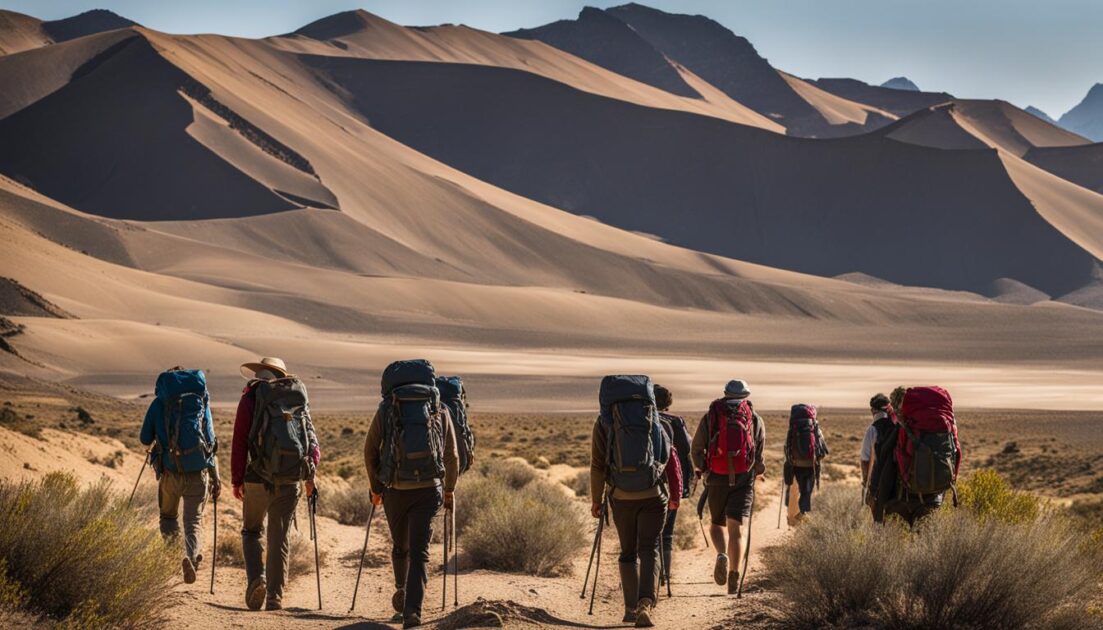Welcome to Death Valley National Park, where the rugged beauty of the desert awaits. As one of the hottest, driest, and lowest national parks in the United States, Death Valley offers a unique hiking experience like no other. In this article, I will guide you through the top hiking trails in Death Valley, provide seasonal tips to make the most of your adventure, and delve into the historical significance and geological wonders of this remarkable park.
Key Takeaways:
- Explore the best hiking trails in Death Valley National Park for a unique and unforgettable outdoor experience.
- Take advantage of the easy trails for beginners or those looking for a more leisurely hike to soak in the scenic beauty of the park.
- Challenge yourself with the hard hiking trails that offer breathtaking views and a thrilling adventure.
- Plan your hike in the cooler months between October and February to avoid extreme summer temperatures.
- Appreciate the historical significance and geological wonders of Death Valley while immersing yourself in its untouched wilderness.
Easy Hiking Trails in Death Valley

Death Valley offers a range of easy hiking trails for beginners or those looking for a more leisurely hike. One of the popular options is the Badwater Basin Salt Flats Trail, which is a short and easy trail that takes you to the lowest point in North America. It’s a unique experience to walk on the salt flats and marvel at the vast expanse of salt crystals. The Zabriskie Point trail is another easy option that offers beautiful views of the eroded hills and mountains in the park. This trail is known for its colorful rock formations and stunning vistas.
If you’re interested in the cultural history of Death Valley, the Harmony Borax Works trail is a great option. This trail takes you through the remains of the borax processing site and provides insights into the area’s rich mining history. It’s fascinating to see the old structures and learn about the hardships faced by the miners in the past. These easy trails in Death Valley provide an opportunity to explore the unique landscapes and natural wonders of the park without too much strenuous hiking.
| Trail | Description |
|---|---|
| Badwater Basin Salt Flats Trail | Short and easy trail to the lowest point in North America |
| Zabriskie Point trail | Offers beautiful views of eroded hills and mountains |
| Harmony Borax Works trail | Provides insights into the cultural history of Death Valley |
Whether you’re a beginner or simply want to enjoy a more relaxed hike, these easy trails in Death Valley offer a chance to immerse yourself in the breathtaking beauty of the park. Take your time, enjoy the unique landscapes, and experience the wonders of Death Valley at your own pace.
Hard Hiking Trails in Death Valley
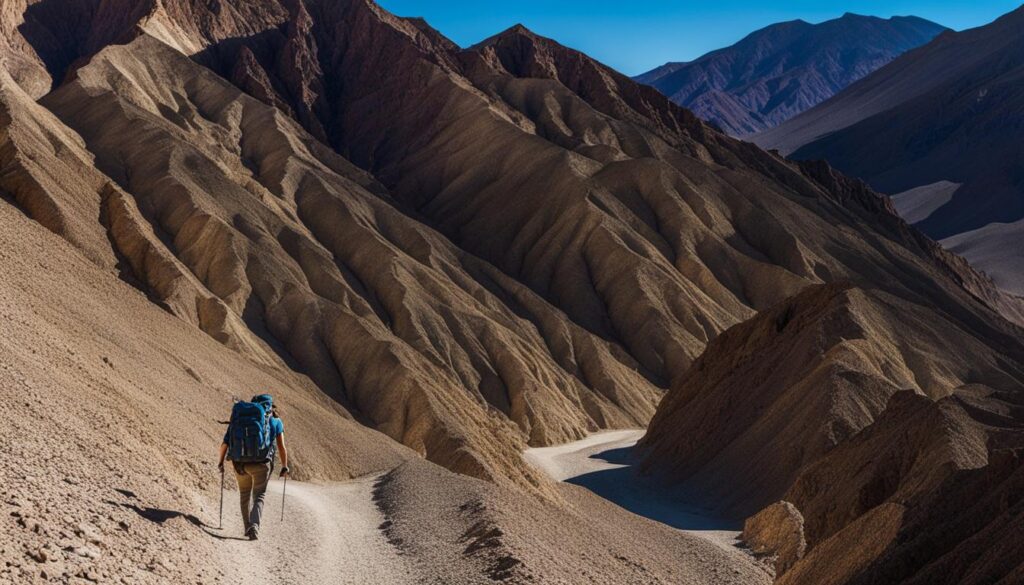
For experienced hikers or those seeking a challenge, Death Valley offers a variety of hard hiking trails that promise both adventure and breathtaking views. One such trail is the Telescope Peak Trail, which takes you to the highest point in the park. This demanding hike rewards you with panoramic vistas of the surrounding mountains and valleys, providing a true sense of accomplishment. Another challenging trail is the Mosaic Canyon Trail, which meanders through narrow slot canyons with steep walls, showcasing the intricate geological formations of the park. Lastly, the Sidewinder Canyon Trail offers an exhilarating experience as you navigate through winding and twisting canyon walls. These hard hiking trails in Death Valley are perfect for hikers looking to push their limits and immerse themselves in the park’s rugged beauty.
The Rewards of Hard Hiking Trails
Embarking on difficult hiking trails in Death Valley not only tests your physical endurance, but also rewards you with remarkable experiences. As you conquer the challenging terrain, you’ll witness stunning panoramic views, untouched desert landscapes, and geological wonders unique to this region. These trails provide opportunities for solitude and reflection, far away from the crowds, allowing you to fully immerse yourself in the natural beauty of Death Valley. Remember to come prepared with proper hiking gear, plenty of water, and a sense of adventure. Exploring these hard hiking trails in Death Valley will leave you with unforgettable memories and a deep appreciation for the park’s rugged allure.
The Importance of Safety
While hard hiking trails can be exhilarating, it is important to prioritize safety during your Death Valley adventure. Make sure to check weather conditions and trail conditions before setting out and be prepared for changing circumstances. Carry essential safety equipment such as a map, compass, flashlight, and a first aid kit. Hiking in a group is highly recommended, as it provides additional support and assistance in case of emergencies. Additionally, always inform someone responsible of your hiking plans, including your intended route and expected return time. By taking these precautions, you can enjoy the challenges and rewards of hard hiking trails in Death Valley while ensuring your safety.
Hiking in Death Valley: Summer vs. Winter

When it comes to hiking in Death Valley National Park, the time of year can make a big difference. As someone who has explored the park extensively, I can tell you that there are distinct advantages and challenges to hiking in both summer and winter.
Summer Hiking in Death Valley
Hiking in Death Valley during the summer months can be an intense experience. With temperatures regularly soaring above 120 degrees Fahrenheit, it’s crucial to plan your hikes carefully and take extra precautions to stay safe.
During the summer, I recommend avoiding hiking during the hottest parts of the day. Instead, opt for early morning or late afternoon hikes when temperatures are slightly cooler. It’s also essential to bring plenty of water, as dehydration can quickly become a serious risk. I recommend carrying at least 4 liters of water per person for a full day of hiking.
Winter Hiking in Death Valley
Winter is the ideal time to explore Death Valley on foot. The weather during this season is much milder, with temperatures ranging from the 50s to the 70s, making it far more comfortable for hiking.
Winter hikes in Death Valley offer a unique opportunity to fully appreciate the park’s scenic viewpoints, geological wonders, and historical significance. With cooler temperatures, you can hike longer distances and have more time to explore the park’s diverse landscapes.
Whether you choose to hike in summer or winter, always remember to check the weather conditions and trail closures before embarking on your adventure. Safety should be the top priority, and being prepared with the right gear, supplies, and knowledge will ensure a memorable and enjoyable hiking experience in Death Valley.
Historical Significance of Death Valley
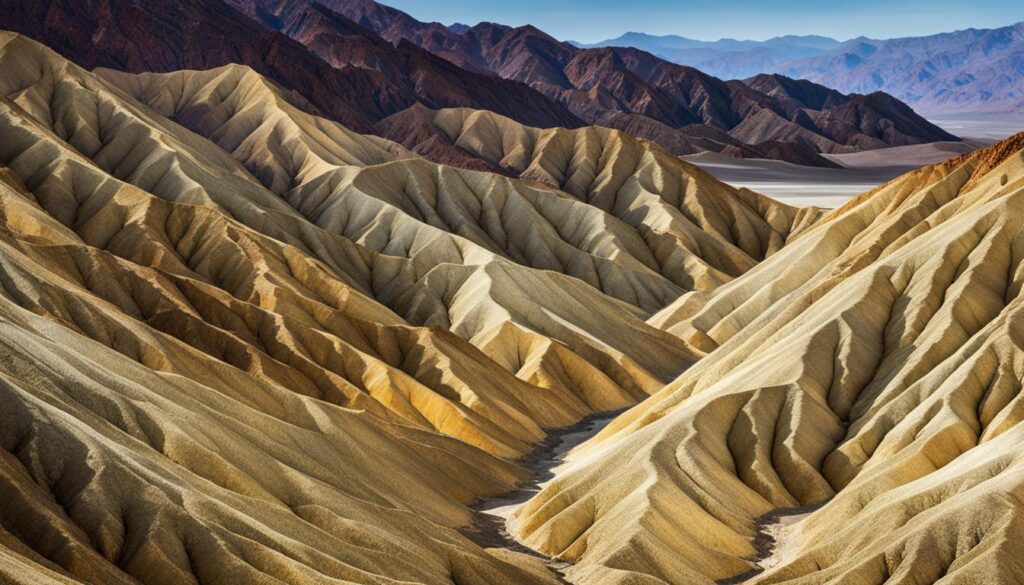
Exploring the hiking trails in Death Valley allows me to connect with the rich history and cultural significance of this unique desert landscape. This vast expanse of land holds a remarkable historical background that dates back to the California Gold Rush. Death Valley played a pivotal role during this era, attracting miners from all over in search of gold and other valuable minerals. The park’s many hiking trails offer an opportunity to step back in time and imagine the arduous journeys undertaken by those seeking their fortunes in this unforgiving environment.
One of the most significant historical sites within Death Valley is the Harmony Borax Works. This location was once a major producer of borax in the late 1800s, which played a crucial role in the development and industrialization of the United States. As I hike through the park and pass by the remnants of this operation, I’m reminded of the tireless efforts of the workers who toiled under harsh conditions to extract this valuable resource.
Death Valley National Park holds a special place in American history, having been established as a national monument in 1933 and then designated as a national park in 1994. This recognition underscores the unique geological and historical significance of this desert landscape. As I delve into the park’s trails and explore its wonders, I am not only surrounded by magnificent natural formations but also by the echoes of the past, where the dreams and struggles of those who came before me still resonate.
Geological Wonders of Death Valley
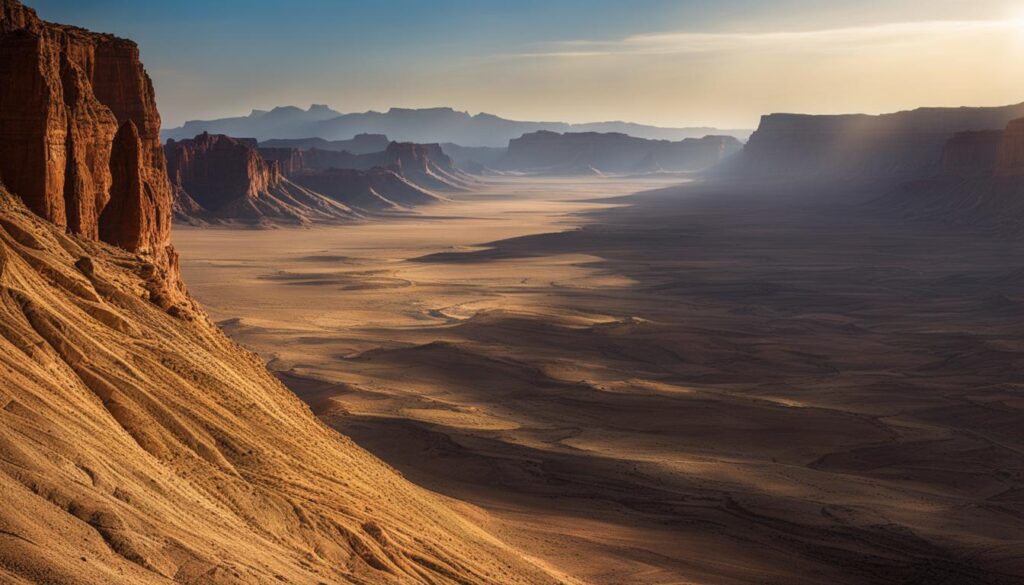
Death Valley is home to a diverse array of geological wonders that showcase the unique and awe-inspiring natural forces that have shaped the park’s landscape. One of the most notable geological features is the Badwater Basin, which is the lowest point in North America, sitting at 282 feet below sea level. This salt flat is formed by the evaporation of an ancient lake, leaving behind a mesmerizing expanse of crystallized salt formations that glisten in the sunlight.
The Mesquite Flat Sand Dunes are another geological wonder in Death Valley. These vast stretches of sand dunes are constantly shifting and changing shape due to the wind. The contrast between the golden sand and the surrounding mountains creates a stunning visual spectacle that is a must-see for any visitor to the park.
Golden Canyon and Gower Gulch are geological wonders that offer a captivating display of colorful peaks and canyons. These formations are the result of millions of years of erosion and geological activity, resulting in a breathtaking landscape of vibrant hues and unique rock formations. Hiking through these canyons allows you to witness the power and beauty of nature up close and personal.
The Geological Wonders of Death Valley
Death Valley is home to a diverse array of geological wonders that showcase the unique and awe-inspiring natural forces that have shaped the park’s landscape. One of the most notable geological features is the Badwater Basin, which is the lowest point in North America, sitting at 282 feet below sea level. This salt flat is formed by the evaporation of an ancient lake, leaving behind a mesmerizing expanse of crystallized salt formations that glisten in the sunlight.
| Geological Wonder | Description |
|---|---|
| Badwater Basin | The lowest point in North America, formed by the evaporation of an ancient lake, resulting in a salt flat of crystallized salt formations. |
| Mesquite Flat Sand Dunes | Vast stretches of sand dunes that constantly shift and change shape, creating a unique and ever-changing landscape. |
| Golden Canyon and Gower Gulch | Colorful peaks and canyons formed through millions of years of erosion, resulting in a breathtaking and vibrant landscape. |
The geological wonders of Death Valley provide a fascinating glimpse into the forces of nature that have shaped this remarkable desert landscape. Exploring these natural wonders while hiking through the park allows visitors to appreciate the immense beauty and power of the Earth.
Wildlife in Death Valley
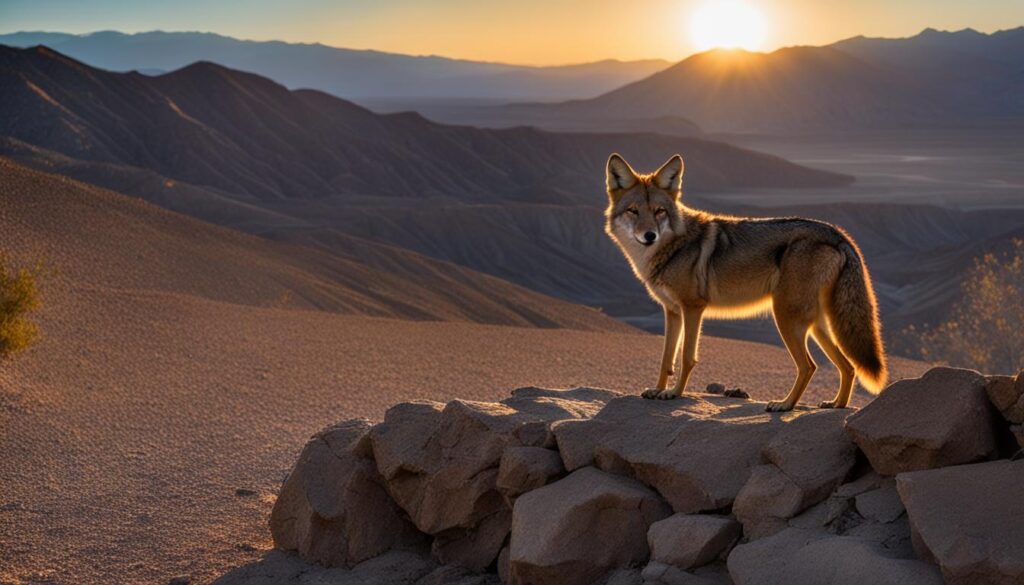
Death Valley, despite its harsh and extreme environment, is home to a diverse array of wildlife. The park offers a unique opportunity to observe and appreciate the animals that have adapted to survive in this desert landscape. From bighorn sheep to kit foxes, Death Valley is teeming with fascinating creatures.
One of the most iconic animals that can be found in Death Valley is the bighorn sheep. These majestic creatures can be spotted scaling the rugged slopes of the mountains in the park. With their impressive horns and agile movements, they are a sight to behold. Coyotes and kit foxes are also common in the park, often seen roaming the desert in search of food.
For birdwatchers, Death Valley is a paradise. Over 300 different species of birds can be found in the park, including roadrunners and golden eagles. Listening to the melodic song of a bird while taking in the breathtaking desert scenery is a truly memorable experience.
Reptiles such as lizards and rattlesnakes also call Death Valley home. These creatures have adapted to the extreme heat and arid conditions, making Death Valley a fascinating ecosystem to explore. Hiking in Death Valley provides ample opportunities to spot these unique reptiles in their natural habitat.
The wildlife in Death Valley is a testament to the resilience of nature. Despite the harsh conditions, these animals have found a way to thrive in this unforgiving environment. Observing them in their natural habitat is not only a thrilling experience but also a reminder of the incredible diversity and adaptability of life on Earth.
Scenic Viewpoints in Death Valley
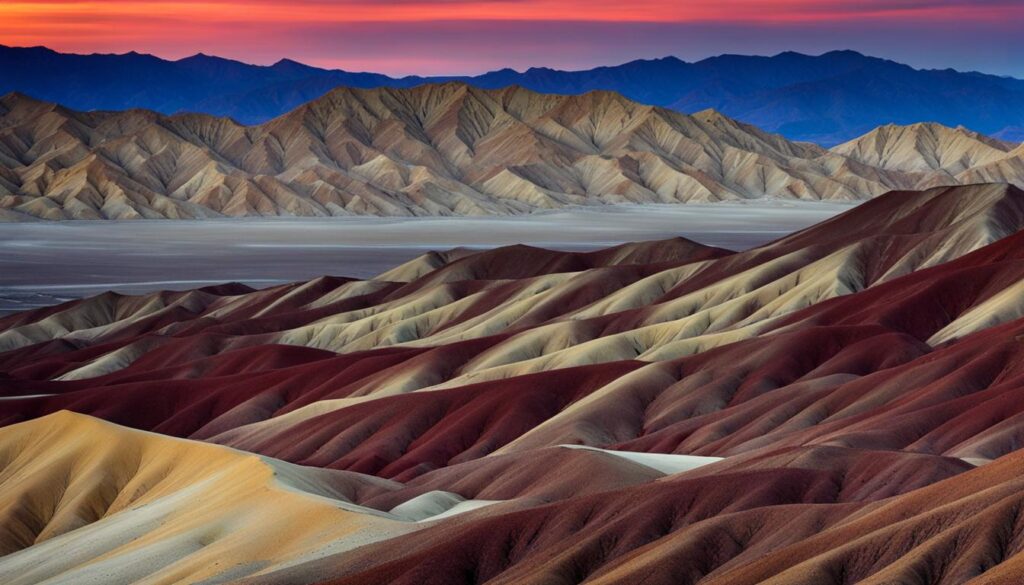
When hiking in Death Valley, one of the most rewarding experiences is reaching the scenic viewpoints that offer breathtaking vistas of the park’s unique landscapes. These viewpoints provide a glimpse into the vast beauty and geological wonders of Death Valley. From eroded hills and mountains to expansive salt flats, each viewpoint offers a different perspective on the park’s diverse features.
One of the must-visit scenic viewpoints in Death Valley is Zabriskie Point. Located in the Furnace Creek Formation, Zabriskie Point offers panoramic views of the colorful and eroded hills that make up the unique geology of the park. It’s a perfect spot to capture stunning photographs of the dramatic landscape. As I stood at the viewpoint, I was in awe of the intricate patterns and vibrant hues of the hills stretching out before me. It truly showcases the immense beauty of Death Valley.
“Standing at Zabriskie Point, I felt a sense of wonder and awe, surrounded by the ancient beauty of Death Valley. The view stretched out before me, a tapestry of geological wonders that reminded me of the immense power of nature.” – Visitor, Death Valley National Park
Another iconic viewpoint in Death Valley is Dante’s View. Situated at over 5,000 feet in elevation, Dante’s View provides a stunning vista of the valley floor below. From this vantage point, I could see the vast expanse of Death Valley, the salt flats shimmering in the distance, and the rugged mountain ranges that surround the park. It’s a breathtaking sight that truly emphasizes the grandeur and scale of Death Valley’s desert landscape.
Lastly, the Harmony Borax Works trail not only offers a peek into the history of borax processing in Death Valley but also provides scenic views of the surrounding desert landscape. As I hiked along the trail, I was captivated by the contrast between the remnants of the borax works and the expansive desert stretching out before me. It’s a unique perspective that combines both the historical and natural wonders of Death Valley.
| Scenic Viewpoint | Description |
|---|---|
| Zabriskie Point | Offers panoramic views of the colorful and eroded hills of the Furnace Creek Formation. |
| Dante’s View | Provides a stunning vista of the valley floor, showcasing the vastness of Death Valley. |
| Harmony Borax Works trail | Offers scenic views of the borax processing site and the surrounding desert landscape. |
Visiting these scenic viewpoints in Death Valley is not just about capturing beautiful photographs, but also about connecting with the raw power and beauty of the natural world. Each viewpoint offers a unique perspective on the park’s geological wonders and serves as a reminder of the incredible forces that have shaped this desert landscape over millions of years.
Trip Planning for Death Valley Hiking
When planning a hiking trip to Death Valley, it is essential to be well-prepared and equipped for the challenging desert environment. As a Death Valley hiking guide, I recommend considering the following essentials to ensure a safe and enjoyable experience:
- Research and choose the right hiking trails: Death Valley offers a variety of trails suitable for different fitness levels and preferences. Whether you’re a beginner or an experienced hiker, there are options available to suit your needs. Take the time to research and select trails that align with your interests and abilities.
- Bring the appropriate hiking gear: Death Valley’s extreme conditions demand proper gear to ensure comfort and safety. Essential items include sturdy hiking boots, a sun hat or cap, sunglasses, sunscreen with a high SPF, a lightweight and breathable clothing layer, and a reliable backpack to carry water and snacks. It’s also wise to have a map, compass, and a GPS device or smartphone with offline maps to navigate the trails.
- Stay hydrated: Adequate hydration is crucial when hiking in Death Valley’s arid climate. Carry a sufficient amount of water based on the length and intensity of your hike, as well as the ambient temperature. It is recommended to bring at least one gallon of water per person per day to prevent dehydration. Remember to drink regularly, even if you don’t feel thirsty.
For those who prefer a guided experience or want to explore more challenging trails, Death Valley hiking tours are available. These tours offer the expertise of experienced guides who can provide valuable insights into the park’s history, geology, and wildlife while ensuring your safety throughout the journey.
Hiking Gear Essentials
| Essential Gear | Description |
|---|---|
| Hiking boots | Sturdy, ankle-supporting footwear for rocky terrain |
| Sun hat or cap | Protects your face and head from the sun |
| Sunglasses | Provides eye protection from the intense desert sun |
| Sunscreen | High SPF sunscreen to prevent sunburn |
| Lightweight clothing | Moisture-wicking, breathable fabrics to stay cool |
| Backpack | Carry water, snacks, and essential gear |
| Map, compass, and GPS | Navigation tools for finding your way on the trails |
“Hiking in Death Valley provides a unique opportunity to explore a breathtaking desert landscape. With proper planning and the right gear, you can have an unforgettable adventure while staying safe and comfortable throughout your journey.” – Death Valley hiking guide.
Safety Tips for Death Valley Hiking
When embarking on a hiking adventure in Death Valley, it is crucial to prioritize safety. The extreme conditions make proper preparation and precautions essential to ensure a safe and enjoyable experience. Here are some safety tips to keep in mind:
1. Stay Hydrated:
The arid desert climate of Death Valley can quickly lead to dehydration, especially during the scorching summer months. Carry an ample supply of water and drink regularly to stay hydrated throughout your hike.
2. Time Your Hike:
Avoid hiking during the hottest parts of the day, particularly in the summer when temperatures can soar to dangerous levels. Plan your hike for early morning or late afternoon when the temperature is more manageable.
3. Protect Yourself from the Sun:
Shield yourself from the intense desert sun by wearing a wide-brimmed hat, sunglasses, and sunscreen with a high SPF. Additionally, consider wearing lightweight, breathable clothing that provides adequate coverage.
4. Hike with a Partner:
It is always advisable to hike with a partner, especially in remote areas. Having someone by your side can provide assistance in case of an emergency and ensure that you have support throughout your hike.
5. Stick to Designated Trails:
While it may be tempting to explore off-trail, it is essential to stay on designated paths. Venturing off-trail can be dangerous and harmful to the delicate desert ecosystem. Follow the marked trails to minimize the risk of getting lost or damaging the environment.
6. Be Aware of Wildlife:
Death Valley is home to a diverse array of wildlife, including snakes and other potentially dangerous creatures. Keep a safe distance from wildlife, avoid touching or disturbing them, and be cautious when exploring rocky or brushy areas.
7. Familiarize Yourself with Emergency Procedures:
Prior to your hike, familiarize yourself with the park’s emergency procedures, including the location of ranger stations and emergency contact numbers. It is essential to have a plan in place should an emergency situation arise.
By following these safety tips, you can ensure a safe and enjoyable hiking experience in Death Valley. Remember to always prioritize your well-being and be prepared for the unique challenges that the desert environment presents.
| Safety Tips | Description |
|---|---|
| Stay Hydrated | Carry plenty of water and drink regularly to prevent dehydration. |
| Time Your Hike | Avoid hiking during the hottest parts of the day; plan your hike for early morning or late afternoon. |
| Protect Yourself from the Sun | Wear a hat, sunglasses, and sunscreen to shield yourself from the intense desert sun. |
| Hike with a Partner | Always hike with a partner to provide support and assistance. |
| Stick to Designated Trails | Follow the marked trails to minimize the risk of getting lost or damaging the environment. |
| Be Aware of Wildlife | Keep a safe distance from wildlife and avoid disturbing them. |
| Familiarize Yourself with Emergency Procedures | Know the location of ranger stations and emergency contact numbers. |
Remember, safety should always be the top priority when hiking in Death Valley. By taking the necessary precautions, you can fully enjoy the awe-inspiring beauty of this unique national park.
Camping Near Death Valley National Park
When planning a visit to Death Valley National Park, camping is a popular option for immersing yourself in the natural beauty of the area. There are several campgrounds within the park that cater to different preferences and needs. Furnace Creek Campground is the largest campground in the park and offers a variety of amenities such as picnic tables, fire pits, and access to restrooms and showers. Sunset Campground, located near Badwater Basin, provides stunning sunset views and a peaceful atmosphere. Texas Spring Campground offers a more secluded camping experience, surrounded by desert landscapes and wildlife.
If the campgrounds within the park are full, there are also nearby camping options just outside of Death Valley National Park. Panamint Springs Resort, located west of the park, offers RV and tent camping along with amenities such as a general store, restaurant, and fuel. Stovepipe Wells Campground, located on the eastern side of the park, provides a convenient location for exploring sand dunes and other nearby attractions.
Campground Comparison
| Campground | Location | Amenities | Reservations |
|---|---|---|---|
| Furnace Creek Campground | Within Death Valley National Park | Picnic tables, fire pits, restrooms, showers | First-come, first-served |
| Sunset Campground | Within Death Valley National Park | Picnic tables, fire pits, restrooms | First-come, first-served |
| Texas Spring Campground | Within Death Valley National Park | Picnic tables, fire pits, restrooms | First-come, first-served |
| Panamint Springs Resort | Outside Death Valley National Park | General store, restaurant, fuel | Reservations recommended |
| Stovepipe Wells Campground | Outside Death Valley National Park | Picnic tables, fire pits, restrooms, showers | First-come, first-served |
When camping near Death Valley National Park, it’s important to plan ahead and make reservations if necessary, as campgrounds can fill up quickly during peak seasons. Be prepared with camping essentials such as a tent, sleeping bags, cooking equipment, and appropriate clothing for the desert environment. Take advantage of the campgrounds’ amenities and enjoy the beauty of the night sky in one of the darkest places in the United States.
Remember to practice Leave No Trace principles and respect the natural environment while camping in and near Death Valley National Park. Leave your campsite as you found it and dispose of waste properly. By camping near Death Valley, you can fully experience the tranquility and natural wonders of this unique desert landscape.
Conclusion
In conclusion, Death Valley National Park offers a truly remarkable hiking experience. With its unique landscapes, rich history, and geological wonders, this park is a must-visit destination for outdoor enthusiasts. Whether you prefer easy trails for a leisurely hike or challenging trails for a more adventurous experience, Death Valley will captivate you with its untouched wilderness and awe-inspiring beauty.
It is important to prioritize safety when hiking in Death Valley. By following proper trip planning, bringing enough water, and staying on designated trails, you can ensure a safe and enjoyable adventure. It is also recommended to visit during the winter months when temperatures are more mild and comfortable.
So pack your hiking gear, prepare for an unforgettable journey, and immerse yourself in the breathtaking landscapes of Death Valley National Park. Discover the historical significance, witness the geological wonders, and appreciate the resilience of the wildlife that thrives in this harsh desert environment. Death Valley awaits, ready to amaze and inspire you.
FAQ
When is the best time to hike in Death Valley?
The best time to hike in Death Valley is during the winter months, between October and February, when temperatures are more mild and comfortable.
What are some easy hiking trails in Death Valley?
Some easy hiking trails in Death Valley include the Badwater Basin Salt Flats Trail, the Zabriskie Point trail, and the Harmony Borax Works trail.
Which hiking trails in Death Valley are more challenging?
Some challenging hiking trails in Death Valley include the Telescope Peak trail, the Mosaic Canyon trail, and the Sidewinder Canyon trail.
What precautions should I take when hiking in Death Valley in the summer?
When hiking in Death Valley in the summer, it is important to avoid hiking during the hottest parts of the day, bring plenty of water, and be aware of the signs of heatstroke and dehydration.
What is the historical significance of Death Valley?
Death Valley has a rich history and played a crucial role in the California Gold Rush. The Harmony Borax Works, located within the park, was one of the largest producers of borax in the late 1800s.
What are some geological wonders in Death Valley?
Some geological wonders in Death Valley include the Badwater Basin, the Mesquite Flat Sand Dunes, and the colorful peaks and canyons of Golden Canyon and Gower Gulch.
What wildlife can be found in Death Valley?
Death Valley is home to a variety of wildlife, including bighorn sheep, coyotes, kit foxes, birds, and reptiles such as lizards and rattlesnakes.
What are some scenic viewpoints in Death Valley?
Some scenic viewpoints in Death Valley include Zabriskie Point, Dante’s View, and the Harmony Borax Works trail.
What should I consider when planning a hiking trip in Death Valley?
When planning a hiking trip in Death Valley, it is important to research and choose the right hiking trails, bring plenty of water and appropriate gear, check the weather conditions and road closures, and consider guided hiking tours.
What safety tips should I follow when hiking in Death Valley?
When hiking in Death Valley, it is important to stay hydrated, hike during cooler parts of the day, wear sun protection, hike with a partner, follow hiking regulations, and stay on designated trails.
Where can I camp near Death Valley National Park?
There are several campgrounds within Death Valley National Park, including Furnace Creek, Sunset, and Texas Spring Campgrounds. If these are full, there are also nearby camping options outside of the park, such as Panamint Springs Resort and Stovepipe Wells Campground.

